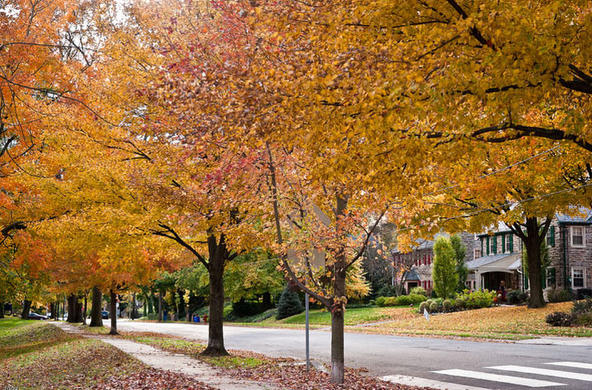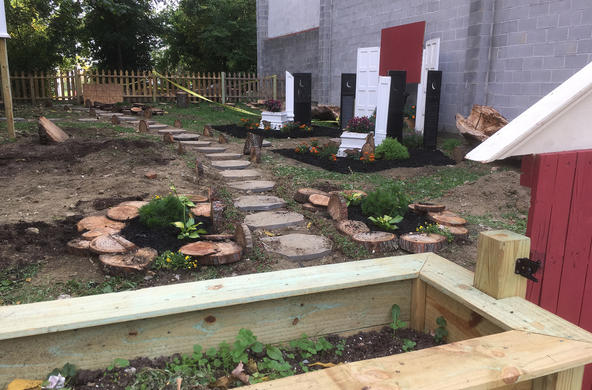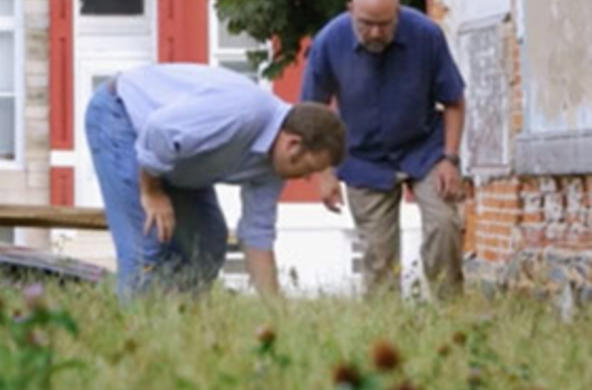Part of the 20-year Baltimore Ecosystem Study (BES), the wildflower project on Lafayette Avenue in Sandtown-Winchester is just one project in a comprehensive scientific study focused on helping Baltimore figure out what exactly blighted neighborhoods need to attract private development investment.
Urban Ecosystems
The term ecosystem is often code for the environment — birds, butterflies, plants and water. But urban ecosystems, like those found in predominately limited income areas of Baltimore, include citizens living in densely populated housing among vacant lots often littered with a mix of shrubbery and trash.
To understand Baltimore’s ecosystems, scientists, researchers, students, nonprofits, universities and government agencies are collaborating on the Cary Institute’s Baltimore Ecosystem Study.
Started in 1997, the long-term research project funded by the National Science Foundation has collected data for urban water and air quality, disease patterns from mosquitoes, biodiversity, forest and greenery spaces, human health and behavioral patterns, all here in Baltimore. What it’s found: When many of these factors are out-of-whack, as in the case of Baltimore’s blighted neighborhoods, the urban ecosystem suffers greatly.
The Role of Vacant Lots and Abandoned Homes
Picture a 50-by-40-foot patch of nasty dirt and weeds in your neighborhood. Now pictures two of these lots randomly interspersed between homes. Some of the homes are vacant with roofs, a few windows and front doors boarded up. The grass and weeds grow high, and trash has found its way to the vacant dirt lots.
Professor Chris Swan at the University of Maryland, Baltimore County has been conducting a two-year study on how to turn these lots into meadows in a cost-effective way. His team is testing 70 such plots against control plots in Baltimore. Each one is fenced in and planted with native plant species.
Swan and his student teams are conducting different tests to find the optimal method to start native plant meadows that will thrive given all types of soils — some of them contaminated. Another Baltimore Ecosystem Study team has revealed that soil lead levels are elevated around old housing stock and in vacant lots.
The perks of this endgoal are evident: Native plant meadows provide beauty, but they also offer habitats for birds, butterflies and pollinators. Meadows only require two mowings a year, half as often as grass lawns. Native plants retain water better than non-natives, which reduces polluted storm runoff.
“On-site testing like this is really hard,” said Swan. “Yet we have figured out that in order to make this work within the community, we need to be out here and talking with our neighbors and sharing the vision.”
Swan said most neighbors are thrilled that the lots are more attractive and have a purpose that’s part of a larger effort.
Three Times As Many Mosquitoes
Turning a dirt plot into a low-maintenance meadow solves another issue: mosquitoes.
The Cary Institute’s mosquito specialist, Heather Goodman, analyzes how citizen education and reduction of mosquito breeding grounds decreases urban mosquito populations.
“Lower income neighborhoods experience three times as many biting mosquitos [as] other neighborhoods because overgrown shrubs and trash are ideal mosquito breeding grounds,” said Goodman.
The tiger mosquito, native to Baltimore, can host the Zika and West Nile viruses, she noted. Her research has concluded that increasing numbers of mosquitoes found in Baltimore’s lower income zip codes carry the West Nile Virus; she’s also found mosquitos are feeding off rats. That makes controlling their populations even more critical.
Greenery and Tree Canopies
Increasing the tree canopy, among other things, falls under Morgan Grove’s domain. Grove is a lead research forester at the U.S. Forest Service Research & Development, another member of the Baltimore Ecosystem Study.
“Sixty percent of Baltimore’s smaller dense and brick housing predates city zoning codes, and 90 percent predates the Environmental Protection Agency,” said Grove. “Baltimore housing is way too dense with a lot of concrete. What we’re trying to instill in Baltimore is more open space with healthy tree canopies and greener lots.”
A tree canopy offers residents shade, beautifies the area and reduces the summer’s heat island effect. Urban concrete and impervious surfaces trap the sun’s heat and lead to hotter temperatures compared to suburban and rural areas.
Grove noted that Detroit, a town with more than 80,000 vacant lots, has an opposite problem compared to Charm City: “Detroit has too much green space and is looking to consolidate housing in villages with farms and open space in between.”
The city’s housing stock “is mostly wood, which explains why land owners burn the property to demolish it,” he added.
Baltimore’s housing stock is mostly brick and therefore costly to demolish. Fortunately, there are efforts like that of Humanim’s Details group, which deconstructs Baltimore homes and resells the valuable bricks and old-growth wood.
So What?
During my visit to see the BES’s progress in Sandtown, Grove touched on the project’s key question: How much needs to happen in a blighted neighborhood to send positive social and economic signals to developers who can restart private sector partnerships?
The study is finding that humans and nature are more connected in urban ecosystems than we once thought. Renewing blighted neighborhoods isn’t as simple as knocking down buildings. It’s also collecting data on how many homes need to be demolished and turned into greener lots that will host birds and parks, not rats.
All BES data is public available. Check out the study’s research and projects and educational opportunities to learn the extent to which our city — with so much potential — is being explored with a top-notch microscope.






